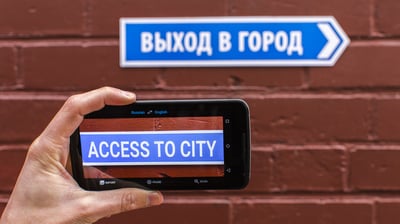April 23, 2025
 by Ankit Bhayani / April 23, 2025
by Ankit Bhayani / April 23, 2025

There were once more than seven thousand languages shaping human communication — until technology took over.
Today, no matter how many languages we know, we all speak a common one: the language of multilingualism powered by AI. With communication breaking down linguistic barriers and international borders, every industry has moved toward multilingual transcription.
But for most industries, it hasn’t always been smooth sailing. Faced with the challenges of inconsistencies and contextually incorrect transcriptions, the reliability of transcriptions has been questioned occasionally. The limitations were soon replaced by advancements as the world blended multilingual transcription with natural language processing (NLP).
So, how exactly does NLP make multilingual transcription smarter and more seamless? Let’s take a closer look.
Multilingual transcription has evolved the usefulness of content in ways that were previously unimaginable. While every industry has had its own upsides from it, below are key areas that saw a wide-scale application of multilingual transcriptions.
Accurate documentation and analysis of languages across countries have helped keep global heritage alive. From cultural studies to fields such as anthropology, accurate representation of dialects has ensured the possibility of cultural preservation.
Industries that rely on cross-language translations, such as music, literature, and art, also depend on transcriptions. A prime example would be the global demand for translating song lyrics. On the surface, these translations fulfill the wants of music fans, but beneath it, they preserve the emotional and cultural essence of art.
On the opposite side of the lens, transliteration has its tricky moments, too. As complex as the term sounds, so is its application. Transliteration is the process of converting words from one script to another. Certain words may lose their intended meaning because of ambiguities in pronunciation and script conversion. Here, we point toward advanced linguistic models that use phonetics, cultural context, and semantics to improve accuracy.
No industry has benefited from multilingual transcription more than the business world. As companies move overseas, they face the problem of dealing with an audience that speaks different languages. Transcription software has turned these obstacles into opportunities by enabling smoother communication, marketing, and interactions.
The core pillar of business communication depends heavily on transcription. Whether it’s adding subtitles, handling multilingual meetings, or promoting an inclusive workplace, multilingualism plays a key role. Take brand slogans, for instance: a trending tagline of a brand may achieve a thunderous response in one language; however, the same tagline may go unnoticed in a different region. Here’s where the inclusion of transcription makes all the difference in the business world.
Living in one country yet curious about others? Multilingual transcription allows you to consume international news from the comfort of your home. News companies use transcription to broadcast live coverage to any corner of the world in their regional language, whether it's through dubbing or subtitles.
Traditionally, professional human transcribers handled multilingual transcriptions, but the process was slow and time-consuming. With the modern problem came the modern solution of AI-driven transcription software, allowing news agencies to deliver instant, accurate translations at scale.
The use cases of multilingual transcriptions are immense. However, although few, their limitations massively outweigh the benefits.
If you’ve ever wondered how computers are learning to understand and process human language, the answer is natural language processing. It’s a branch of artificial intelligence now hailed as the bridge between humans and computers.
NLP not only drives a higher percentage of accuracy but also attracts efficiency, even in the most protracted tasks. Unlike traditional transcription services that process speech word-by-word for accurate translation, NLP systems analyze the entire context of a sentence. This distinction completely eliminates any room for errors in the translation, ensuring that the intended meaning of the word isn’t lost.
On a larger scale, numerous corporate giants are accustomed to large volumes of data backed by a tight deadline. In such scenarios, NLP stands as the best weapon in their arsenal to attain the desired output. With the estimated demand for transcription and translation services amounting to $98.11 billion by 2028, the implementation of NLP is bound to be the new normal. NLP-powered tools and models can easily recognize regional accents and even the most feared dialects when trained.
But, the question remains: Can NLP actually enhance the use of transcription?
Studies suggest that the NLP market is expected to reach $48.31 billion in the current year. Here are three major areas where the integration of NLP is making a difference:
Even if we rule out all the regional languages, we are still left with over 150 languages commonly used by companies during interactions with other brands, clients, customers, etc. While most of these languages can be translated and transcribed with ease, certain languages, like Mandarin, present challenges because of their complex characters. However, NLP innovations witnessed over the years have tackled this issue quite effortlessly.
Semantic matching, one of the features of NLP models, makes sure that the translated content aligns with the original text’s intended meaning. This is valuable for professional human transcribers who skim through the transcribed document. What’s more, NLP models come with automated quality-checking ability. Most NLP models are trained to conduct automated quality checks on the content that detect and rectify all the mistakes in real time.
Media and broadcast companies have been the most successful in expanding their reach and operations to address even the world's remotest regions through real-time subtitling of live events. They enhance diversity and engagement by removing language barriers and addressing the users in their native tongues.
Customer support, for example, has also been a game-changer in real-time multilingual conversation by returning responses promptly and accurately to customers irrespective of their language. Real-time transcription, along with NLP, helps international conferences and events where the presenter can communicate with multilingual audiences without the need to use interpreters. This promotes understanding and solidarity among participants, along with simplifying communication.
NLP models aren’t bulletproof when blended with multilingual transcription. Here are a few aspects that still require progress and experiments to achieve perfection:
If we flip through the records of the Guinness Book of World Records, 58 is the maximum number of languages spoken fluently by a single person. If the person were replaced with a computer, the number would shoot up, but the reliability would fall in a single swoop.
Unlike most languages that have an interconnection among a few of their words, languages such as Mandarin or Arabic would heat the system of every machine. The intricate grammatical structures of these languages, followed by cultural context, confuse most of the NLP tools.
The outcome derived from NLP models hinges on the volume and quality of data used to feed them. From regional dialects to variations, every single aspect contributes toward the present-day limitations of achieving 100% translation and transcription accuracy.
It’s one of the key factors that hold back the narrative of unlocking the true potential of NLP — a barrier that can be taken down through crowdsourcing data from native speakers and partnering with local communities.
Our language keeps evolving, with new words appearing out of the blue each day — especially among Gen Z and younger generations. Yet, most transcription software or audio-to-text converters lack the level of comprehension needed.
For starters, transcription models could easily misinterpret the phrase ‘break the ice’ and take it literally when the phrase is all about initiating a conversation or easing built-up tension. In such cases, NLP has shown great accuracy in recognizing these idioms and phrases by carefully analyzing the conversations and understanding the context.
Consider languages that most of us have never even heard of, e.g., Dumi, Ainu, etc. Although the population that speaks these languages is relatively small, these still hold cultural and linguistic importance. It becomes a daunting task even for most of the NLP models to be well-versed in the unique dialects of these languages, marking it as one of the major issues in multilingual transcriptions through NLP models.
Since NLP models rely on massive datasets to operate accurately, this dependence raises questions about ethics and privacy. These models are widely used in industries such as the legal and medical fields, where data privacy and security are the number one priority for companies. As a result, strict measures must be implemented in NLP transcription, such as anonymity, encryption, advanced tools that limit access, etc, to safeguard sensitive information.
Beyond privacy concerns, NLP models must bear the responsibility of meeting all the necessary compliances. Compliance with regulations like the General Data Protection Regulation (GDPR) forms an additional layer of trust and transparency that further propels the evolution of NLP and multilingual transcription.
Despite these challenges, NLP continues to break new ground in multilingual transcription.
We’ve carefully analyzed both sides of the coin. Although NLP is undoubtedly a revolutionary tool in transcription, the progress we have yet to make cannot be overlooked. These include:
International relations lie on the thin thread of mutual understanding, benefits, and cooperation of countries. NLP-powered multilingual transcription has the strength to achieve a giant leap in international relations and shedding attention to cultural differences. Presently, we’ve observed several occasions wherein NLP models were utilized to provide real-time translation, bridge language barriers between government officials, and promote cross-cultural dialogue.
All these applications in the real world hint toward a future where every international company employs NLP-powered multilingual transcription to drive efficiency and more business. Looking ahead, it’s safe to predict that the entire world is bound to move toward a seamless and simplified life pioneered by NLP.
Curious about tools that put speech recognition into action? Explore our list of the best voice recognition software of 2025 to see how voice-to-text technology is evolving across platforms.
Edited by Monishka Agrawal
Ankit Bhayani, CEO of Konch, heads a pioneering transcription service focused on AI and NLP to deliver accurate and cost-effective solutions. With a Master’s from Syracuse University and over 10 years of experience, he is passionate about user-centric innovations in transcription, translation, and much more.
In April 2006, Google launched Google Translate, an app that started out as an online-only...
 by Rebecca Reynoso
by Rebecca Reynoso
Humans can decipher words organically due to the brain's central signals. They can interpret...
.png) by Shreya Mattoo
by Shreya Mattoo
We use search engines all the time, but we aren’t always the best at asking questions.
 by Brooks Manley
by Brooks Manley
In April 2006, Google launched Google Translate, an app that started out as an online-only...
 by Rebecca Reynoso
by Rebecca Reynoso
Humans can decipher words organically due to the brain's central signals. They can interpret...
.png) by Shreya Mattoo
by Shreya Mattoo


